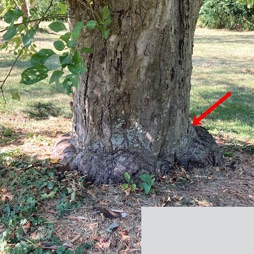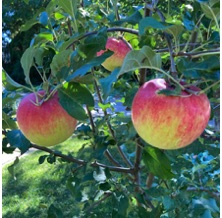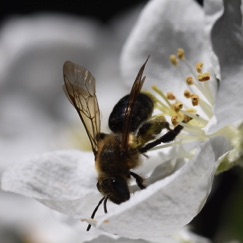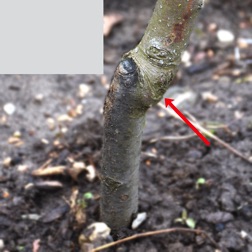
Cultivars and how they're grown

Domestic apples (Malus domestica or alternatively Malus pumila) are originally from Europe and Asia. They are a cultivated crop, but they have so often escaped into the wild and naturalized that they have become part of our natural landscape in North America.
Grafting is the process in which a small branch (scion) is cut from the tree and attached to the cut stem base of a small tree of another kind (the rootstock). The grafted scion then develops into a tree that is genetically identical to the named original. Only the trees roots and the very base of the trunk are of a different genetic type, that of the rootstock, which is usually a variety developed for hardiness and tree size.
The graft point is usually visible as a bulge on the stem near the ground in younger trees, although it may be less obvious in old trees. Sometimes the rootstock produces shoots; these are usually trimmed off, but in older, unmaintained trees these may develop and eventually produce fruit that will be different, and presumably less desirable, than the grafted part of the tree. In old, abandoned orchards, the grafted cultivar may even have died, leaving only a rootstock tree.
In another form of grafting, buds are cut from a cultivar and attached to the trunk of another cultivar, produced a branch of the grafted type. Such trees may have many cultivars producing many fruit types on one tree. Aside from providing an array of fruit, having more than one kind of flower on the same tree helps with pollination (see next section).
Why not grow apples from seeds?
Where cultivars come from, and the joy of pippins
Apple trees are grown from seed all the time by breeders working to develop new varieties, as they combine desirable traits of existing cultivars (and even related species, in some cases). When the right offspring is found it is named, cloned and promoted, becoming a new cultvar. 'Empire', for example, is a cross of 'Mcintosh' and 'Red Delicious'.
What our tests can (and can't) tell you
The genetic test we do compare an unknown tree to the known genotypes of many apple cultivars. When a tested tree does not match anything in our available genetic databases, this could be because:
(1) The tree is a cultivar, but it is not one we have in our database or other databases we have access to. If we can't identify your tree but it is obviously grafted and/or is obviously an orchard tree, (1) is a strong possibility. When we can't identify trees, we recheck them as we add new cultivars to our database, so it is always possible we will still provide you with an identification in the future.
(2) The tree is not a cultivar, but rather, it is a pippin.
(3) The tree is a rootstock that grew up after the grafted part of the tree died. We have a few rootstock cultivars in our database, but in older orchards, rootstocks were sometimes just whatever was available (e.g. a seedling found in the orchard), so these are frequently unidentifiable
Regardless of which of the above possibilities is correct, we will provide any information we can about the possible parentage of the unidentified tree. This may help in identifying a possible unknown cultivar, or it may provide some insight about cultivars grown in the area in the past.


Bee pollinating a apple flower
This need for cross-pollination is the reason that farmers must be careful to plant more than one cultivar in their orchards, and to make sure that blocks of one cultivar are not too large: pollen carried by bees from a different cultivar must be able to reach every tree in the orchard. If seeds are not produced, fruit is not produced. This is also why you are advised to plant at least two cultivars in your yard, unless you know there are other apple trees nearby.
Because seeds are the result of a cross between two genetically different trees, they will not be identical to the mother. A 'Mcintosh' seed will not produce a 'Mcintosh' tree. Even in unusual cases of self-fertilization, the genotype of the cultivar will be jumbled and resorted, so even a “selfed” seed will not be identical to the mother. The only time a seed is identical to the mother is when a seed asexually produced (a seed produced without fertilization), but this appears to be a rare phenomenon.

Graft point on young tree
Apple trees also grow all the time from seeds that are deposited by humans, deer or other animals all throughout the landscape, especially along fence lines, the edges of woods, barnyards and compost piles. Trees that grow from seed spontaneously this way are traditionally called pippins. Feral apples, which are trees growing in naturalized conditions outside of human cultivation, are almost all pippins. Every pippin is genetically unique, just as every person is genetically unique. They do not share the genotype of any cultivar, or of any other pippin. Pippins are, however, the source of many cultivars, including most heritage cultivars. For example, 'Mcintosh' started out as a pippin that was found, appreciated, and cloned over and over again.
Graft point on old tree
When a particular apple tree is seen to be especially desirable, it is given a name, like 'Mcintosh', 'Northern Spy', or 'Bloody Ploughman', and propagated through a type of cloning called grafting. All trees that share a name are therefore genetically identical clones of the original tree. We call these genetically identical varieties cultivars (cultivated varieties). 'Mcintosh', for example, is a cultivar: all 'Mcintosh' trees are grown from grafted tissue, and all 'Mcintosh' trees are genetically identical, aside from rare small mutations that occur over time. It is the fact that they are all genetically identical (they all have the same genotype) which allows us to identify cultivars.
Seeds from a particular cultivar will NOT produce a tree that is genetically identical to the mother. Although apple flowers have both male parts (the stamens, producing pollen) and female parts (the ovary, style and stigma), apples are self-incompatible. This means that the pollen of a cultivar can almost never fertilize the ovules of its own flowers. This is true even if the pollen comes from a different tree of the same cultivar because the trees are genetically identical. Seeds are therefore only produced by crosses between two genetically different trees, often two cultivars in an orchard.
Many of the apple trees we encounter are pippins, especially along roads, fence lines, trails, in forests, around old homesteads and on the edges of old orchards. These trees are often much loved and provide us with a fascinating variety of sizes, tastes and colours. Some may be very old, because domestic apples have been grown in North America for hundreds of years, and your tree may have grown from a seed dropped by a deer or a farmer a century ago. Some pippins of today may may become the cultivars of tomorrow.
Because every pippin is genetically unique, our genetic tests cannot “identify” them in the way we can identify cultivars. We can sometimes identify cultivars that could have been the parent of a particular pippin, if they share a certain proportion of their genes with the pippin, but parental identifications of this kind are only tentative with the test we use.
